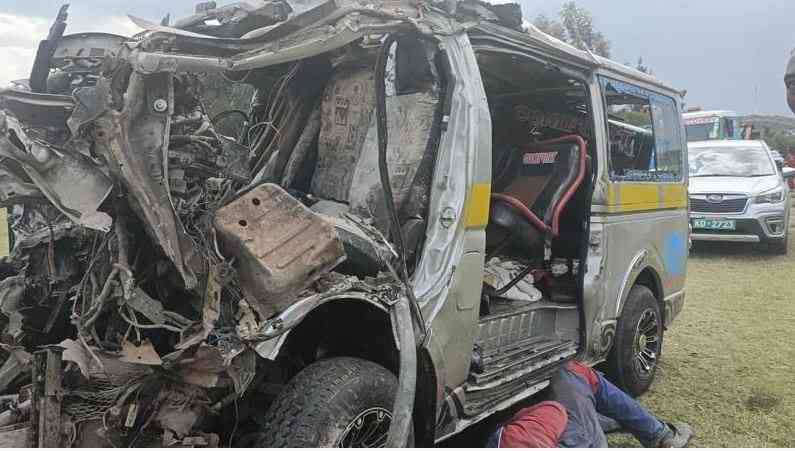After years of controversy, inefficiency, and deep public frustration, National Transport and Safety Authority (NTSA) Director General George Njao has finally exited office leaving behind an agency in shambles and a trail of disillusioned Kenyans who expected better. For many Kenyans, it’s a sigh of relief rather than a moment of nostalgia.
For many road users, transport operators, and safety advocates, Njao’s departure feels long overdue. His tenure has been marked not by reform or progress, but by a steady decline in NTSA’s credibility, functionality, and integrity. His tenure brought a deep disconnect between NTSA and the very stakeholders it was meant to serve.
A Broken System Left Behind
The NTSA that Njao leaves today is a shadow of what it was meant to be a once-promising regulator turned into a bureaucratic maze where corruption thrives, systems frequently fail, inconsistent policies, to the rising number of road carnage and ordinary Kenyans bear the cost.
License verification systems collapse for days, vehicle inspections are riddled with irregularities, and road safety enforcement has become more of a revenue game than a public protection mission.
Instead of leading the agency into modernization and transparency, Njao presided over its gradual breakdown allowing inefficiency to fester while confidence among road users and stakeholders dwindled.
Corruption and Rot within the Agency
Under his watch, the NTSA became a synonym for graft. From the issuance of driving licenses and inspection stickers to questionable road safety tenders, corruption stories have been constant.
For many, it became evident that the agency was no longer serving the people but rather serving private interests under the guise of regulation.
Even with mounting public complaints, internal reports, and parliamentary scrutiny, there was little visible effort to clean up the rot or hold anyone accountable. The silence and inaction spoke louder than words.

Road Safety at Its Worst
Ironically, the very agency tasked with saving lives on our roads has presided over some of the worst safety records in recent years.
Kenya’s road carnage has continued to claim thousands of lives annually a grim reflection of a failed system that has lost both direction and discipline.
Public education campaigns dwindled, enforcement became selective, and data management which is crucial for policy planning became unreliable.
It is no exaggeration to say that under Njao’s tenure, road safety in Kenya deteriorated to its lowest point in a decade.
A DG Who Fought to Stay, Not to Serve
Instead of using his time in office to build systems that would outlast him, George Njao reportedly did everything possible to extend his term beyond the standard three years.
He fought not to reform the institution, but to secure his seat at a time when the country needed visionary leadership to overhaul the broken transport safety framework.
His departure, therefore, is not just the end of a term. It marks the conclusion of an era where personal ambition overshadowed public service.
Call for Accountability: EACC Must Step In
George Njao’s exit from NTSA should not mark the end of scrutiny it should be the beginning.
For too long, the agency has operated under a cloud of corruption, inefficiency, and deliberate neglect. Public resources have been misused, systems manipulated, and road safety compromised all under the watch of a man who seemed more focused on clinging to office than cleaning it up.
The Ethics and Anti-Corruption Commission (EACC) must now launch a thorough investigation into Njao’s tenure at the NTSA.
Kenyans deserve to know:
- How billions meant for road safety and automation projects were utilized.
- Why critical NTSA systems broke down repeatedly without accountability.
- Who benefitted from the licensing, inspection, and tender corruption networks that flourished under his administration.
Accountability cannot end at resignation. Leaving office does not erase responsibility.
The rot within NTSA did not happen by accident it was a product of leadership failure, complicity, and impunity.
EACC must hold George Njao and his collaborators personally accountable for the breakdown of public trust, the collapse of vital systems, and the loss of lives that could have been prevented with an effective, transparent NTSA.
Time for a Rebirth at NTSA
As the nation looks forward, there’s hope that this exit could open the door for real reform and accountability.
NTSA must be rebuilt from the inside out with transparent systems, digital efficiency, and leadership that prioritizes lives over revenue and politics.
The next Director General must restore public confidence and return NTSA to its core mission: making our roads safer, our systems cleaner, our transport sector truly accountable and stakeholder engagement not bureaucratic control and silence.
Because after years of neglect and decay, Kenyans deserve an NTSA that works not one that watches as chaos unfolds on our roads.
Conclusion
Geroge Njao leaves behind a wounded institution and a trail of unfulfilled promises. But his exit also presents a rare opportunity to reset.
NTSA can still reclaim it’s rightful place as a trusted authority for safer, smarter roads but only if the new leadership will have the courage to confront the failures of the past and build from the ground up.



